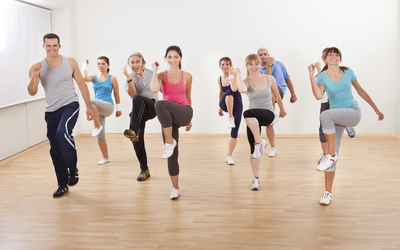How to Make the Most of Your Aerobic Sessions
Aerobics is a fantastic form of exercise for strengthening the muscles, improving circulation and the respiratory system, and building stamina. A typical class lasts around 30 to 60 minutes and usually begins with a warm-up, and ends with a cool-down section. There are several different forms of this exercise, including step aerobics, kickboxing and Tae Bo. Step aerobics is a great platform for strength training, and involves quite literally stepping up onto and down from a portable platform whilst performing the exercises.
Kickboxing is a sporting martial art form which is similar to boxing and uses the feet as well as the hands for striking movements. A session of kickboxing involves abdominal crunches, jumping jacks, leg lifts and punching for a total body workout. Tae Bo is a programme which combines Tae kwon do and boxing, as well as aspects of dance, to provide a really effective workout. The name stands for Total, Awareness, Excellence, Body and Obedience. With step aerobics, the fitness level of the person is determined by the height of the step, the leg length, stepping skill and coordination. To begin with, individuals should begin on the lowest step so that they can stay within an appropriate aerobic training zone of 60 to 75 percent of their maximum heart rate. They usually start off with a four-inch step, and as this becomes easier the height of the step can be increased to a maximum of 10 inches. With kickboxing, gloves may be added to the workout for additional resistance and protection. However, once you add gloves to your workout you need to reduce the duration of punches – continual punching for longer than ten or 15 seconds isn’t recommended with the same arm.
Regular exercise can have a wonderful effect on your health and wellbeing, and can reduce your risk of developing certain health problems. For example, obesity can increase the risk of coronary heart disease, osteoarthritis, sleep apnea, type 2 diabetes and hypertension. Exercising is one of the best ways of maintaining a healthy weight, so it can help to keep you healthy in a number of ways. It can also build and maintain a healthy skeletal and muscular system, can prevent premature death and lowers the risk of developing depression and anxiety. If you’re new to exercise, taking it slow is important to avoid damaging the muscles or joints, or risking injury. In fact, most trainers or fitness experts would agree that it’s best to consult your GP before undertaking any exercise or embarking on a programme so that you can check that it’s safe for you. This is particularly the case for people with pre-diagnosed health problems, such as heart disease or diabetes, as exercising too strenuously could make the problem worse.
Physical exercise can lead to dehydration, so it’s vital that you drink plenty of water before, during and after you exercise. If you’re exercising on a step aerobics programme, the ‘loaded’ knee should never flex beyond a 90 degree angle. This refers to the lead leg that lifts onto the step. Your hip joint should always be a few inches higher than the knee. Even if you’re fit, kickboxing carries a lot of injury risks so you should be wary of these. Overextended kicks, locked joints and exercising when you’re fatigued all increase the risk of damage to the body so it’s advised you train with a professional at least until you’ve learnt how to perform the moves in the correct way. The same risks are attributed to Tae Bo, so seek the advice of a trainer to begin with.


Comments are closed.